The Future Of Private And Consent-Based Marketing

Apple’s iOS14.5 privacy updates. Google’s third-party cookie ban. There’s a fresh wind of upcoming changes blowing through the field of digital marketing and advertising.
And most marketers are stressed, anxious or all-out panicking because of the… unprecedented times ahead.
We wanted to clarify some of the details of these changes, their consequences, and share our vision of what the future of marketing and advertising will look like. Hint: it’ll be more private and consent-based than ever before. More on that below.
We’ll also show you how we’ve anticipated these changes. A quick look at the marketing tools we’ve been building will help you understand what might be next. These tools are specifically designed for SMBs and D2C brands in ecommerce.
Are you a merchant or marketer working in ecommerce? Keep reading, as this post should be especially interesting for you and your business.
Table of Contents
How advertising is radically changing in 2021 and beyond
How this influences programmatic advertising specifically
What these changes mean for SMBs in D2C ecommerce and retail
Exchanging quick sales for loyalty and retention
Solutions: how to develop and maintain a fanbase
The return of Kevin Kelly’s 1000 True Fans theory
How we anticipated these changes and how we can help
The future of marketing is private and consent-based
The Omni Opt-in: relevant and timely alerts through every step of the customer journey
How advertising is radically changing in 2021 and beyond
Yes, advertising strategies are going to change radically in 2021 and beyond. Cross-app data tracking will require user permission on iOS devices - the upcoming update includes the App Tracking Transparency (ATT) feature. Third-party cookie tracking in Chrome will be turned off by default.
 App Tracking Transpareny will change a lot of cross-app tracking practices
App Tracking Transpareny will change a lot of cross-app tracking practicesAnd this is going to hit SMBs in (D2C) ecommerce and retail harder than in other industries. After years of relying on third-party cookie tracking for retargeting and lookalike targeting, marketers will need to find a new way to drive product sales.
How this influences programmatic advertising specifically
Here are two common ways advertisers were previously able to depend on these data tracking strategies to pick up easy sales:
- running ads to retarget people who visit their sites
- using lookalike modeling to target ads to people who share characteristics with existing customers
Since Google will stop allowing advertisers to deterministically link a single user to a Google ID request all the way through to conversion, a lot of performance marketers will see these tactics failing.
Moreover, while these advertising techniques are tried and tested, the sales they produce are usually made by one-time, spur-of-the-moment type buyers. Which is great if you need quick and easy revenue injections. But it’s not what builds long lasting ecommerce empires.
 Lookalike audiences will become a less effective targeting method
Lookalike audiences will become a less effective targeting methodThese advertising strategies are like the high-fructose corn syrup food in a digital marketer’s diet.
But does this mean that we should consider them healthy practices in the long run?
And what alternatives are there, now ecommerce marketers can no longer depend on third-party data for retargeting and lookalike audiences to acquire new customers?
What these changes mean for SMBs in D2C ecommerce and retail
In essence, ads will have to be targeted way more broadly. Because of this, especially SMBs with lower budgets will suffer. Where before, they could rely on third-party cookie and cross-app data tracking to get quick and easy sales, now return on ad spend (ROAS) will drop significantly. And the lower the ad budget, the more significant the effects.
This isn’t to say that these changes are final and there are no alternatives to previous tracking and targeting strategies.
Google has been working on a ‘privacy-first future for web advertising’ using “interest-based” advertising ad-tech. Namely the Federated Learning of Cohorts (FLoC) technology. But how effective FLoC will be at replacing previous targeting tactics is still to be determined.
Note: other privacy-focused browsers like Brave and DuckDuckGo already started blocking Google's FLoC.
 The browser wars continue with cookies as the divisive issue
The browser wars continue with cookies as the divisive issueAs for now, what can SMBs in D2C ecommerce and retail do, then, to limit these effects on their marketing and advertising strategies?
Exchanging quick sales for loyalty and retention
First of all, we’re likely to see a change of focus to owned audiences and data. Social channels and on-site behavior will become way more important, as these closed networks can still be used to create retargeting loops.
As a result, first-party data (what happens or is collected in-app or on-site) will become way more valuable. The ways in which you can collect data are being limited, so the data you can still collect will suddenly increase in value.
If you’re a merchant that’s already collected email addresses for your newsletter or built a large Instagram following - owned data - you’re one step ahead of the competition.
But a more significant change is how businesses will need to start investing even more in relationships with their customers. We’d argue this is a great development for end-users, anyway.
Recent customer transaction data research by Tinuiti, a company that manages Google ad campaigns, shows smaller brands get 50% of revenue from 16% to 20% of their customers.
What does this mean for ecommerce customer acquisition strategies?
Loyal, recurring customers are already essential to a healthy, long-term ecommerce strategy. With the upcoming inability to rely on advanced targeting to rack up quick one-time sales, a strategy focusing on fostering 1-on-1 relationships to retain existing customers is going to be even more important.
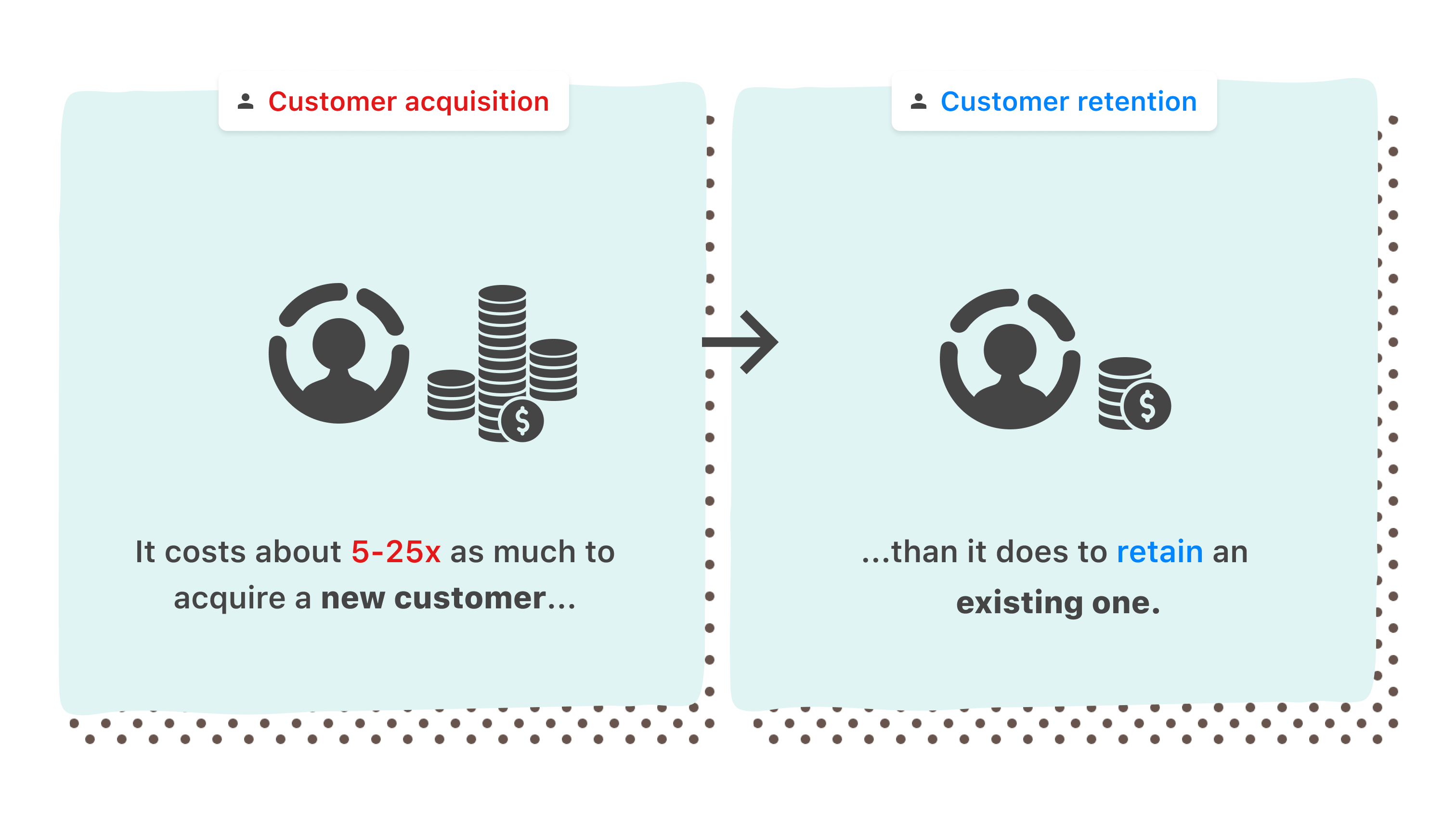 Customer acquisition is 5-25x more expensive than customer retention
Customer acquisition is 5-25x more expensive than customer retentionIn the words of Nii Ahene, chief strategy officer at Tinuiti:
“For marketers, spending more time on loyalty, trying to turn a one-time buyer into a repeat buyer, that’s going to be a switching philosophy.”
The future of ecommerce marketing for smaller brands and D2C businesses lies in optimizing for customer retention. Which they should have been doing already, were it not for addictive advertising strategies based on third-party cookie tracking.
We’re not the only ones using the term ‘addiction’ here, by the way. Here’s what renowned researcher Les Binet said in response to Adidas and eBay acknowledging that they had become addicted to performance marketing:
“The addiction to the short-term is not a new phenomenon, but it has got a lot worse. One of the problems is that (for) short-term activities, you get immediate feedback: responses, clicks, or short-term sales. [ . . . ] With the arrival of e-commerce in particular, and digital metrics in general, all of business is now afflicted by the same problem. All businesses now have short-term metrics, which can distract them from long-term growth.”
 Source: Binet & Field 2013
Source: Binet & Field 2013Brand building is simply a more viable long-term growth solution
In short: the biggest danger in being addicted to short-term results is losing sight of long-term growth. This means that resources previously spent on display ads will have to be reallocated to fostering customer loyalty and creating brand fans and advocates.
Solutions: how to develop and maintain a fanbase
If you’re familiar with ShopPop’s history, you might know that we started out as a platform to support artists and creators in reaching their fans directly. We’ve always been firm believers in helping brands engage their audiences and build long lasting relationships with their fans.
For ecommerce businesses, the same strategies apply. Customer loyalty and retention stands and falls with a personalized, 1-on-1 approach to engaging your customers. A smooth and frictionless customer experience is crucial too.
This means optimizing your online store’s customer journey. From discovery to checkout, and from the unboxing moment to post-purchase messaging, delighting your customers will boost your brand and increase retention rates.
Tracking in-store behavior and using this data to personalize your marketing campaigns is key. Make your brand more human with conversational touchpoints like live chat and chat marketing campaigns. This contributes to developing a proper fanbase of loyal customers.
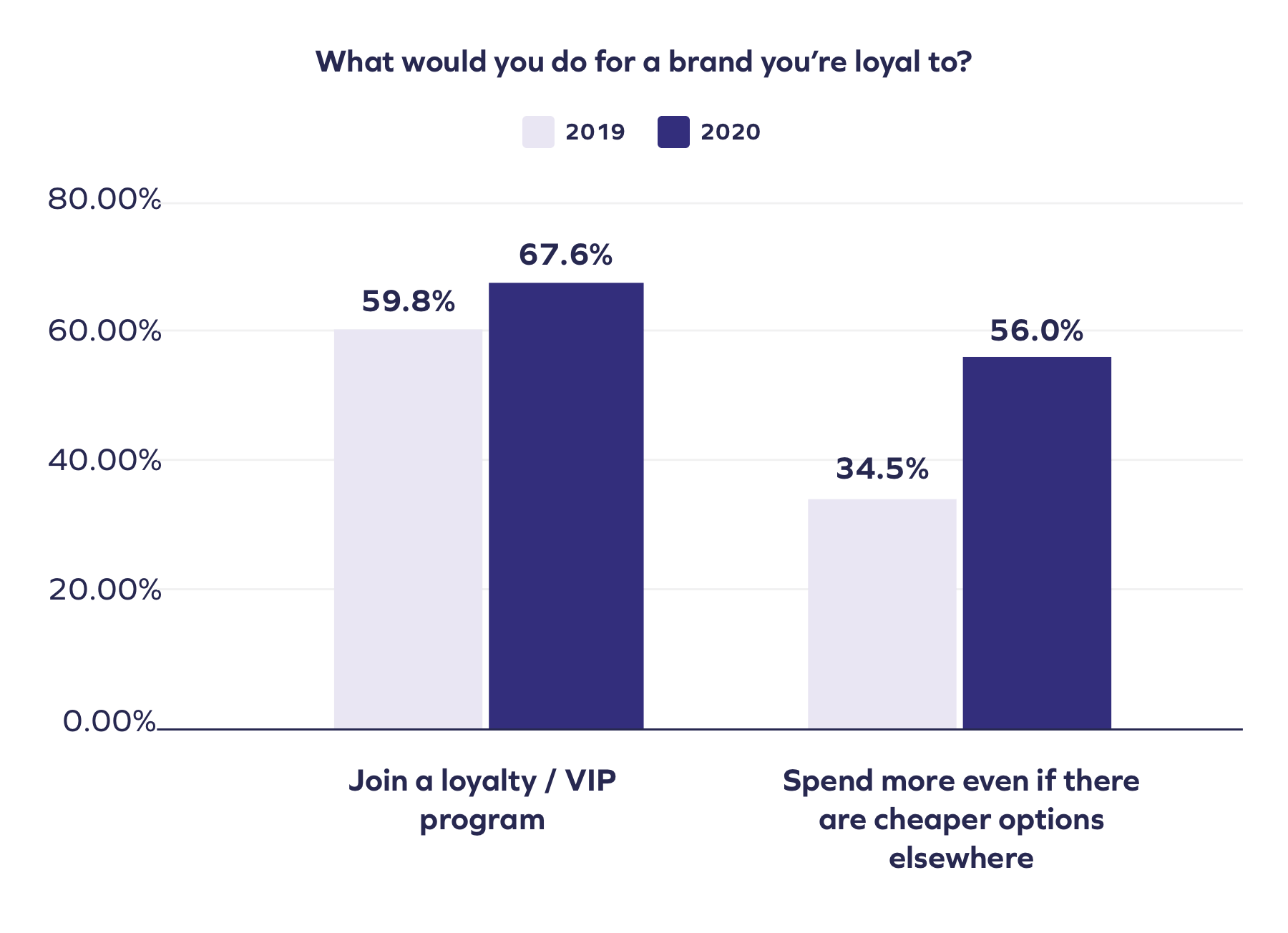 Source: Yotpo
Source: YotpoOf course, loyalty programs that offer discounts, top-notch customer service and return policies, and regular alerts for upcoming deals and promotions all help maintain your fanbase.
Don’t be afraid to sunset uninterested customers either. Nothing weakens the relationship with customers as much as spamming them with unwanted marketing material.
The return of Kevin Kelly’s 1000 True Fans theory
Consider this quote from Wired magazine’s founding executive editor Kevin Kelly’s famous essay on ‘1000 True Fans’:
“To be a successful creator you don’t need millions. You don’t need millions of dollars or millions of customers, millions of clients or millions of fans. To make a living as a craftsperson, photographer, musician, designer, author, animator, app maker, entrepreneur, or inventor you need only thousands of true fans.”
For a breakdown of the concept, here’s a video that summarizes it pretty well:
Even though Kelly’s essay was originally written in 2008, the concept still stands, and is even more applicable with the imminent disappearance of short-term advertising results:
If you focus on fostering a direct relationship with a 1000 True Fans and these fans spend $100 on your business each year, your business will already operate at $100k ARR.
For most SMBs or D2C ecommerce brands, this is a big deal. More importantly, this approach is a lot more viable for long-term growth, as true fans, i.e. loyal customers, means recurring income.
In 2021, where ‘privacy-first’ changes made by major players like Google and Apple are changing the digital advertising landscape, this 13-year old theory suddenly regained much of its former relevance.
Not convinced yet?
GrowthLab did some research into the data behind their customers, and found the their top 1000 fans spent 5x as much as the rest of their customers:
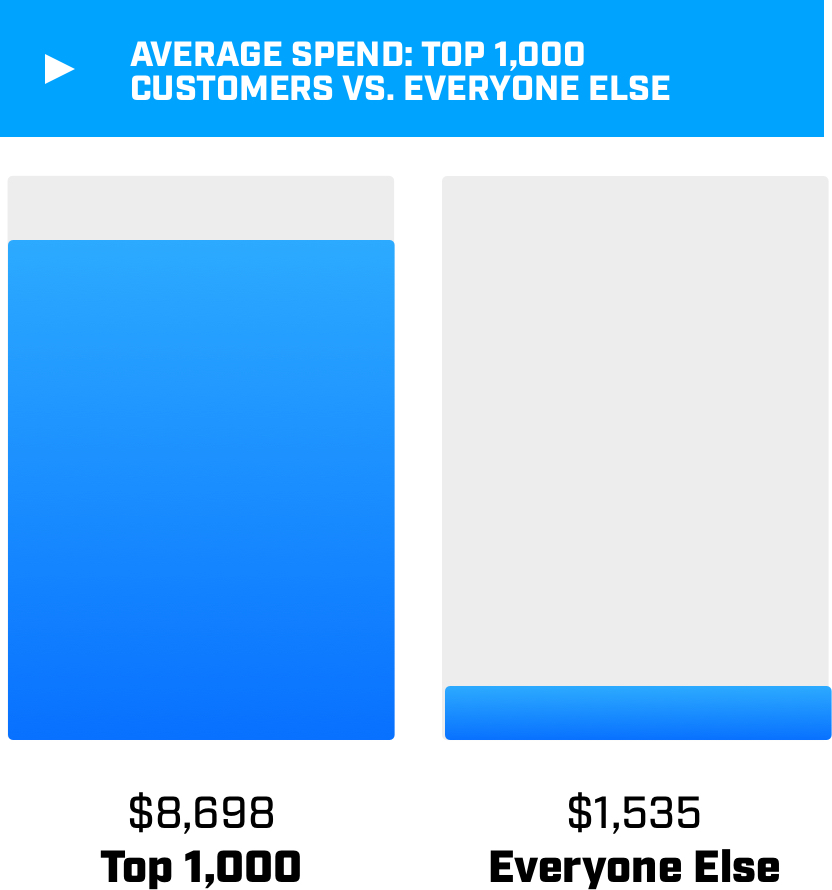 Average spend of top 1000 customers for GrowthLab
Average spend of top 1000 customers for GrowthLabAnd it’s safe to say that those top 1000 customers are also the ones that will keep making repeat purchases. Focusing on direct relationships with those 1000 customers will help you establish a healthy growth model for your business.
So much for what’s been happening and how we see things changing. Let’s take a look at what’s next from ShopPop.
How we anticipated these changes and how we can help
First of all, ShopPop was founded in response to what Benedict Evans termed the ‘Death of the News Feed’.
All social apps grow until you need a newsfeed
— Benedict Evans (@benedictevans) January 22, 2018
All newsfeeds grow until you need an algorithmic feed
All algorithmic feeds grow until you get fed up of not seeing stuff/seeing the wrong stuff & leave for new apps with less overload
All those new apps grow until...
As social media news feeds became increasingly saturated, with creators and brands becoming more and more dependent on these news feeds, we foresaw a shift towards more direct forms of businesses interacting with their customers and fans online.
And we weren’t the only ones…
The future of marketing is private and consent-based
In 2019, Facebook founder and CEO Mark Zuckerberg published an article titled ‘A Privacy-Focused Vision for Social Networking’. In this post, Zuckerberg described how he believed that “the future of communication will increasingly shift to private, encrypted services.”
The Facebook company’s reflected this vision of the future by adding interoperability between WhatsApp, Messenger, and Instagram DM on their roadmap, and emphasizing the importance of Facebook Groups and communities as a way out of cluttered news feed models.
From the moment of ShopPop’s inception, we’ve been building tools to help automate 1-on-1 interactions on messaging apps that people already use, in anticipation of the move from public news feeds to private modes of communication.
With 2020 and COVID-19 turning the world on its head, and the resulting ecommerce boom, we decided to integrate our chat marketing platform with Shopify, to better support merchants in sending timely and relevant messages to their customers, on the same messaging apps.
The Omni Opt-in: relevant and timely alerts through every step of the customer journey
Worldwide, different regions prefer different messaging apps, but the most widely used and important ones are still Messenger and WhatsApp.
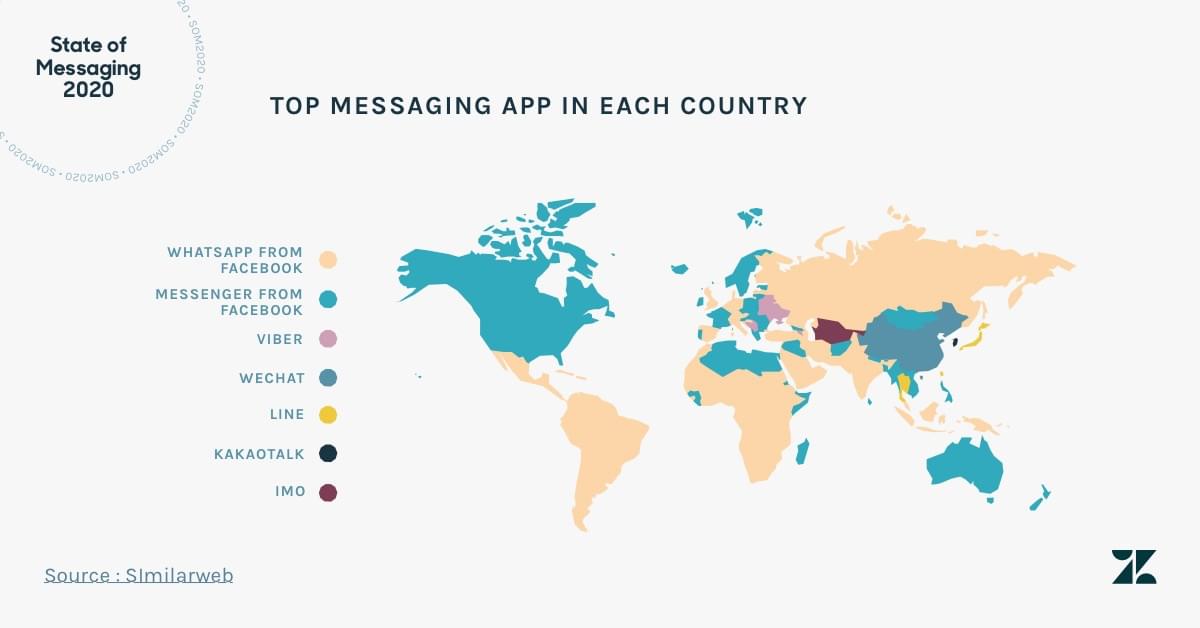 State of Messaging 2020. Source: Zendesk
State of Messaging 2020. Source: ZendeskAnd if you’re an ecommerce business serving a global audience, providing the ultimate customer experience to boost brand loyalty and create true fans for your business, means offering your customers options.
Messaging through chat apps is direct, can’t get lost in the algorithms of a news feed, or end up in spam or promotion email folders. At the same time, we firmly believe that consent-based marketing is the future of how businesses and consumers will interact with each other.
Which is why we’ve been building the Omni Opt-in tool for merchants. The Omni Opt-in is a purely high signal marketing tool:
“When it comes to communicating with a business, I prefer only being given the information I am really interested in,” says ShopPop founder, Tim Heineke. “Customers are willing to opt in to that kind of messaging. If it’s relevant to them and you don’t spam them, this benefits both the end customer and the store.”
The Omni Opt-in is a simple button on your store that lets people opt in to receive a one-time notification on specific topics.
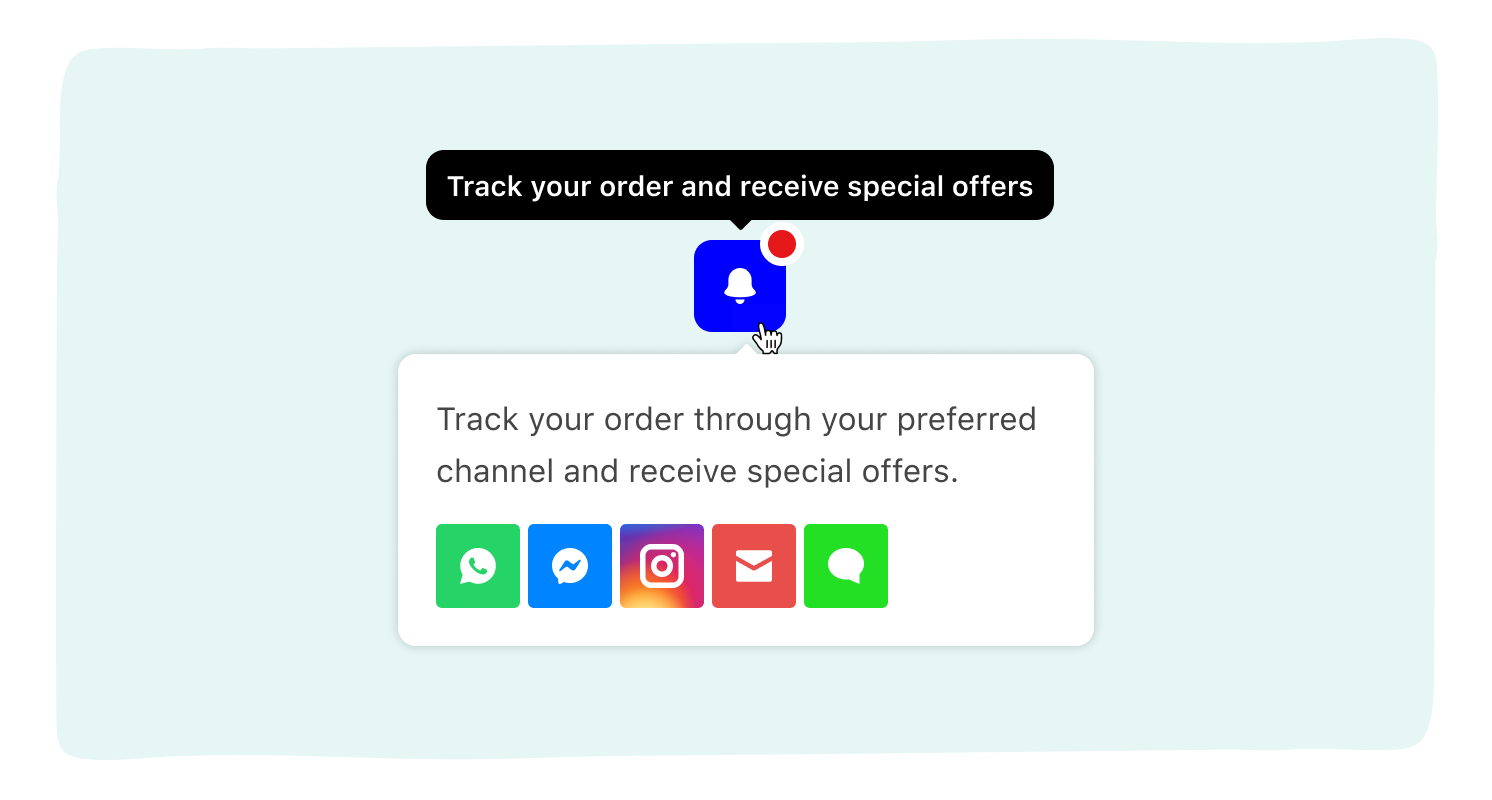 Omni Opt-in for merchants
Omni Opt-in for merchantsThink of back in stock notifications, new product drops or sale alerts for your favorite brands. Next to receiving receipts, shipping information, abandoned cart reminders or post-purchase offers.
The customer can choose where to receive their alerts: on Messenger (and soon Instagram DM), WhatsApp, or SMS (RCS or Apple business chat).
Heineke: “We’re making marketing relevant again, which is increasingly important in a world where tracking user data for contextualized ads is a thing of the past. Google is phasing out third-party cookie tracking and Apple is making similar changes at iOS level. The current ad business is changing irreversibly, and we’re here to shape the future that takes its place.”
The messages you automate using the Omni Opt-in tool are exhaustive and one-time only, meaning people will have to opt in for the next message explicitly. Instead of irrelevant newsletters, too many email updates or downright spam, people opt in to receive a one-time message.
This type of consent-based, private 1-on-1 marketing is not only in line with developments we see at major platforms like Facebook, Apple, and Google.
It’s also the perfect way to support long-term growth strategies for SMBs and D2C brands in ecommerce that want to focus on building relationships, brand loyalty, recurring customers and true fans.
Interested in trying out the Omni Opt-in for your store? Get in touch by sending an email to hello@shoppop.com.
Or why don't you connect to ShopPop directly through Messenger at https://m.me/shoppophq